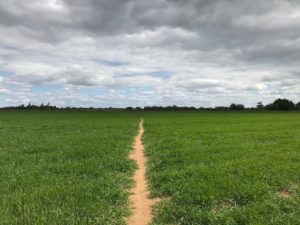Crossrail took 20 years, and ran billions over budget, and only one of the three lines is open so far. But it’s open. And that’s something. For over the past decade or so I’ve grown pessimistic about the prospect of any work of civil engineering ever being delivered, to any kind of schedule or budget, in modern Britain.
Some of the difficulty seems to arise from the sheer weight of what’s already there, whether it’s regulations, houses, roads, communities, title deeds, drains, vested interests and so on. A nation that’s centuries into its current iteration, on an island continuously inhabited by humans for 40,000 years, has had the opportunity to accumulate a hefty overlay of stuff, at least some of which has to be flattened or else worked around if you’re going to build anything new.
But it isn’t just the weight of history gumming us up. The Victorians had nearly as much history as we did, and they managed to crack on: Paddington Station went from planning decision to opening Isambard Kingdom Brunel’s magnificent steel-framed structure in three years, between 1851 and 1854. But somewhere between Brunel and today, urban planners first began to worry about the impact of grand plans on ordinary people, and then to grow just as worried about the impact of ordinary human activities on our ability to deliver grand architectural schemes. And the entire contemporary urban and ex-urban layout of the whole South East is shot through with this tussle, which we could characterise as the politics of abstraction.
To explain what I mean by such a politics, let me describe two consecutive days of getting lost, in two similar but also very different woodlands: the Ramble in New York’s Central Park, and a patch of publicly owned forest close to me in Britain. These spaces cover a similar amount of ground, and are both (in human terms anyway) mainly used for leisure. Both are riddled with little paths. But how they got their walkways, and thus how it feels to move through them, couldn’t be more different; and this difference illustrates something subtle and characteristically modern about how we build today.
The term for a path that appears spontaneously, because someone or something often needs to pass that way, is a “desire path”. Here’s one near me, crossing a field of half-grown wheat.

Desire paths are rarely straight, but rather follow the line of least effort through the landscape. They’re maintained by usage: the one in the picture disappears briefly, every year, when the farmer ploughs and sows the field — then, every time, it’s trodden back in within a few days. Such footways capture an emergent, organic way of using space, which blurs the boundaries between humans and the rest of the animal kingdom. We are, after all, not the only species to take regular routes through our home areas — and by doing so, over time, write on the soil with our feet.
On a dogwalk the other day, I turned off the main path down what looked like a well-trodden side route, only to find it getting narrower and more overgrown and eventually disappearing altogether, into an obstacle-course of brambles and fallen trees. At that point, I realised it probably wasn’t made by humans at all, but the badgers, foxes and muntjac deer that make their homes there. For a moment, the woods felt uncanny — as though (despite the distant sound of car noise, and a plane overhead) I had left the human world briefly behind.
Nothing like this happens in Central Park, even though the maze of winding paths known as the Ramble is designed to simulate that experience. First formally opened in 1859, a few years after Paddington Station and with the ambition typical of both Britain and America in the 19th century, it was designed by Frederick Law Olmstead as a “wild garden”.
Unlike my local woodland, though, here the paths mark a distinct boundary between the human and animal worlds, neatly delineated by little fences that make it clear where humans are invited to tread. And while it’s possible to get pleasantly lost there, as I did, in doing so you never leave the human world for even a second.
The desire-path-like experience of the Ramble has been, for perhaps a century and a half, the closest urban planners have got to creating spaces that feel as though they emerge organically from a place. Rather, the emphasis has been on grand visions, set out by confident men on big pieces of paper, then imposed from the top down: the architecture of abstraction.
In Brunel’s day, at the height of British imperial self-confidence, engineers and architects alike felt a God-given right to remodel the world and everything in it according to such grand visions. The result, along with many fine railways and canals, was mile upon mile of suburban terraces in London, laid out on loosely rectangular patterns of side-streets. More abstract still, the streets on New York’s Manhattan Island were given their grid layout between 1811 and 1821.
By the late 19th century, though, a new generation of planners worried about the alienation from nature that came from living in such built-up environments. One influential thinker, Ebenezer Howard, responded to this with a new vision: garden cities. In Garden Cities of To-Morrow (1902), Howard set out his dream of a new kind of conurbation, that would reduce urban alienation by blending green space with wide, curving streets intended to mimic the natural curvature of organically-emerging desire paths.
Howard’s vision still wasn’t very organic, though. The original garden-city vision was formed of concentric circles, bisected at equal intervals by straight lines: a very geometric kind of naturalness. But if Ebenezer Howard sought to improve British city life by re-introducing (however stiffly) more curvature into the built environment, a few decades later another influential urbanist would try to fix cities not with an orderly echo of the organic, but by doing away with it altogether.
In The City of Tomorrow, (1929) the modernist architect and urban planner le Corbusier dismissed desire paths derisively as chemins de l’âne – donkey paths. For him, such routes expressed animalistic “looseness and lack of concentration”: physical signs of our failure to strive for a life of pure reason. Le Corbusier denounced any urbanism that gave space to such meandering routes as a threat to the man who “walks in a straight line because he has a goal and knows where he is going”.
Instead of encouraging such slackness, le Corbusier declared that homes should serve as “machines for living in”: engines to power rationality and productivity for both sexes. He dreamed of demolishing chaotic, human-scale buildings, envisioning instead a high-rise, symmetrical and orderly Radiant City where streets would follow a grid and humans could be kept from the “ruinous, difficult and dangerous curve of animality”.
These twin poles of modern urbanism’s fraught relationship with “naturalness” shape the whole South-East of England. City centres follow le Corbusier’s footsteps, sprouting glass-and-steel skyscrapers that tower over older structures like alien arrivals formed of pure idea. On the periphery, new construction takes a more Howardesque approach, rolling out vaguely garden-inflected dormitory estates (all without Howard’s integrated Garden City amenities, but complete with “naturally” meandering cul-de-sac roads).
And I don’t think it’s a coincidence that the South East is also the part of Britain most hopelessly gripped by housebuilding paralysis, and a more general Nimby-ish resistance to new architectural impositions. It’s not just about traffic, or noise, or population: somewhere in the resistance to every such scheme is an inchoate rejection of how abstract they all are.
Not one is of a place. Not one is built in accordance with local vernacular, or even local topography — let alone local desire paths. Every bit as much as the tower blocks that now dwarf London’s skyline, or the artificially meandering synthetic randomness of the Ramble, such estates owe their approach — and unpopularity, whenever they are proposed — to a worldview less grounded in place than in pure abstraction.
Perhaps, one might say, the key thing is to build more houses; but perhaps, too, we might wonder whether this resistance isn’t a sign of deeper malaise. That’s certainly the sense emerging from the architectural campaign group Create Streets. Longstanding advocates of walkable streets, human-scale building and construction for place and community, their Restitch summit hopes to find answers to a growing fear, across political divides, that “the fabric of Western society is unravelling”.
I doubt this unravelling is happening merely because people think new-build estates are ugly. But there’s a sense across both architecture and politics that something fundamental about the compact between the great (who make abstract plans), and the small (who have to live in them), has come radically adrift. The Elizabeth line is surely the exception. For if it stumbled to fruition, it is surely down to bucking this trend.
As a project, it is place-bound in just the way every skyscraper and housing-estate is not. It may be a large-scale civil engineering project, but it’s laboriously built round, through and under what’s already there. And, importantly London needs and wants it. For the rest of us, though, it’s a matter of luck if you get any say in how the place where you live is remodelled around you — or if such a remodelling has any regard at all to the organic paths that were there before the bulldozers arrived.
How likely are we to see this change? A pessimist might say: for desire paths to express the organic social fabric, there has to be a social fabric to express. A more upbeat response might be: simply leading ordinary lives in a place is what forms such a fabric, as well as what forms desire paths. But we need leaders with the courage not just to impose a vision, but also to be guided by those emerging patterns.
Disclaimer
Some of the posts we share are controversial and we do not necessarily agree with them in the whole extend. Sometimes we agree with the content or part of it but we do not agree with the narration or language. Nevertheless we find them somehow interesting, valuable and/or informative or we share them, because we strongly believe in freedom of speech, free press and journalism. We strongly encourage you to have a critical approach to all the content, do your own research and analysis to build your own opinion.
We would be glad to have your feedback.
Source: UnHerd Read the original article here: https://unherd.com




